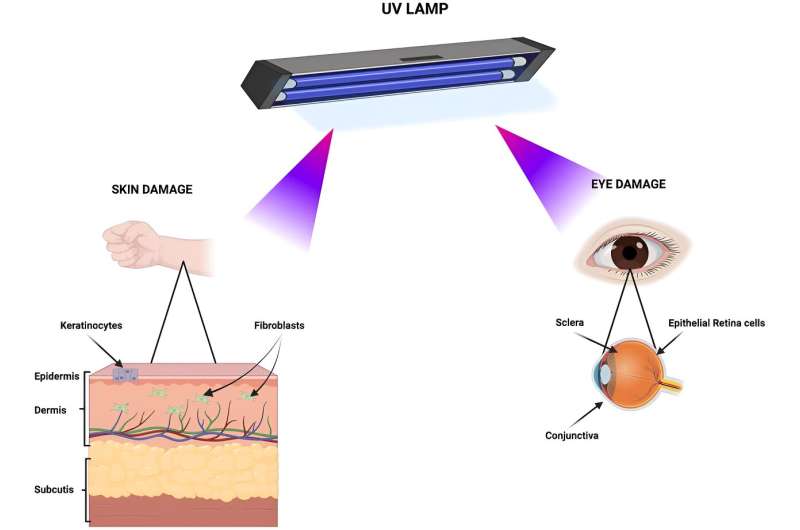This article has been reviewed according to Science X's editorial process and policies. Editors have highlighted the following attributes while ensuring the content's credibility:
fact-checked
proofread
Germicidal lamps using UV-C radiation may pose health safety issues

A new research paper titled "Germicidal lamps using UV-C radiation may pose health safety issues: a biomolecular analysis of their effects on apoptosis and senescence" has been published in Aging.
The battle against the COVID-19 pandemic has spurred a heightened state of vigilance in global health care, leading to the proliferation of diverse sanitization methods. Among these approaches, germicidal lamps utilizing ultraviolet (UV) rays, particularly UV-C (wavelength ranging from 280 to 100 nm), have gained prominence for domestic use.
These light-emitting diode (LED) lamps are designed to sanitize the air, objects, and surfaces. However, the prevailing concern is that these UV lamps are often introduced into the market without adequate accompanying information to ensure their safe utilization. Importantly, exposure to absorbed UV light can potentially trigger adverse biological responses, encompassing cell death and senescence.
In this new study, researchers Nicola Alessio, Alessia Ambrosino, Andrea Boggi, Domenico Aprile, Iole Pinto, Giovanni Galano, Umberto Galderisi, and Giovanni Di Bernardo from the University of Campania Luigi Vanvitelli, Regional Public Health Laboratory in Siena, Italy, ASL Napoli 1 Centro P.S.I. Napoli Est-Barra, and Temple University performed a series of investigations aimed at comprehending the biological repercussions of UV-C radiation exposure from readily available domestic lamps.
"Our focus centered on epithelial retinal cells, keratinocytes, and fibroblasts, components of the skin and ocular targets frequently exposed to UV irradiation," the researchers write.
Their findings underscore the potential harm associated with even brief exposure to UV, leading to irreversible and detrimental alterations in both skin cells and retinal cells of the eye. Notably, epithelial retinal cells exhibited heightened sensitivity, marked by substantial apoptosis. In contrast, keratinocytes demonstrated resilience to apoptosis even at elevated UV doses, though they were prone to senescence. Meanwhile, fibroblasts displayed a gradual amplification of both senescence and apoptosis as radiation doses escalated.
"In summary, despite the potential benefits offered by UV-C in deactivating pathogens like SARS-CoV-2, it remains evident that the concurrent risks posed by UV-C to human health cannot be ignored," the researchers conclude.
More information: Nicola Alessio et al, Germicidal lamps using UV-C radiation may pose health safety issues: a biomolecular analysis of their effects on apoptosis and senescence, Aging (2024). DOI: 10.18632/aging.205787


















